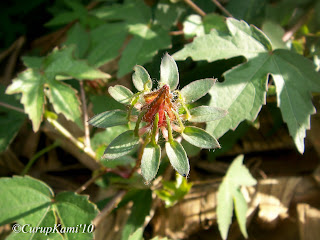The roselle (Hibiscus sabdariffa) is a species of Hibiscus native to the Old World tropics, used for the production of bast fibre and as an infusion. It is an annual or perennial herb or woody-based subshrub, growing to 2–2.5 m (7–8 ft) tall. The leaves are deeply three- to five-lobed, 8–15 cm (3–6 in) long, arranged alternately on the stems.
The flowers are 8–10 cm (3–4 in) in diameter, white to pale yellow with a dark red spot at the base of each petal, and have a stout fleshy calyx at the base, 1–2 cm (0.39–0.79 in) wide, enlarging to 3–3.5 cm (1.2–1.4 in), fleshy and bright red as the fruit matures. It takes about six months to mature.
The plant is considered to have antihypertensive properties. Primarily, the plant is cultivated for the production of bast fibre from the stem of the plant. The fibre may be used as a substitute for jute in making burlap. Hibiscus, specifically Roselle, has been used in folk medicine as a diuretic, mild laxative, and treatment for cardiac and nerve diseases and cancer.
The red calyces of the plant are increasingly exported to America and Europe, where they are used as food colorings. Germany is the main importer. It can also be found in markets (as flowers or syrup) in some places such as France, where there are Senegalese immigrant communities. The green leaves are used like a spicy version of spinach. They give flavor to the Senegalese fish and rice dish thiéboudieune. Proper records are not kept, but the Senegalese government estimates national production and consumption at 700 t (770 short tons) per year. Also in Myanmar, their green leaves are the main ingredient in making chin baung kyaw curry.
In East Africa, the calyx infusion, called "Sudan tea", is taken to relieve coughs. Roselle juice, with salt, pepper, asafetida, and molasses, is taken as a remedy for biliousness.
The heated leaves are applied to cracks in the feet and on boils and ulcers to speed maturation. A lotion made from leaves is used on sores and wounds. The seeds are said to be diuretic and tonic in action and the brownish-yellow seed oil is claimed to heal sores on camels. In India, a decoction of the seeds is given to relieve dysuria, strangury, and mild cases of dyspepsia. Brazilians attribute stomachic, emollient, and resolutive properties to the bitter roots.
Location: Teladan Village, South Curup District, Rejang Lebong Regency
References :
The flowers are 8–10 cm (3–4 in) in diameter, white to pale yellow with a dark red spot at the base of each petal, and have a stout fleshy calyx at the base, 1–2 cm (0.39–0.79 in) wide, enlarging to 3–3.5 cm (1.2–1.4 in), fleshy and bright red as the fruit matures. It takes about six months to mature.
| Scientific classification | |
|---|---|
| Kingdom: | Plantae |
| (unranked): | Angiosperms |
| (unranked): | Eudicots |
| (unranked): | Rosids |
| Order: | Malvales |
| Family: | Malvaceae |
| Genus: | Hibiscus |
| Species: | H. sabdariffa |
| Binomial name | |
| Hibiscus sabdariffa L. | |
The plant is considered to have antihypertensive properties. Primarily, the plant is cultivated for the production of bast fibre from the stem of the plant. The fibre may be used as a substitute for jute in making burlap. Hibiscus, specifically Roselle, has been used in folk medicine as a diuretic, mild laxative, and treatment for cardiac and nerve diseases and cancer.
The red calyces of the plant are increasingly exported to America and Europe, where they are used as food colorings. Germany is the main importer. It can also be found in markets (as flowers or syrup) in some places such as France, where there are Senegalese immigrant communities. The green leaves are used like a spicy version of spinach. They give flavor to the Senegalese fish and rice dish thiéboudieune. Proper records are not kept, but the Senegalese government estimates national production and consumption at 700 t (770 short tons) per year. Also in Myanmar, their green leaves are the main ingredient in making chin baung kyaw curry.
In East Africa, the calyx infusion, called "Sudan tea", is taken to relieve coughs. Roselle juice, with salt, pepper, asafetida, and molasses, is taken as a remedy for biliousness.
The heated leaves are applied to cracks in the feet and on boils and ulcers to speed maturation. A lotion made from leaves is used on sores and wounds. The seeds are said to be diuretic and tonic in action and the brownish-yellow seed oil is claimed to heal sores on camels. In India, a decoction of the seeds is given to relieve dysuria, strangury, and mild cases of dyspepsia. Brazilians attribute stomachic, emollient, and resolutive properties to the bitter roots.
Location: Teladan Village, South Curup District, Rejang Lebong Regency
References :
- http://en.wikipedia.org/wiki/Roselle_(plant)
- http://davesgarden.com/guides/pf/go/2112/





mau dong , boleh bawak pulang gak toeh,
ReplyDeletehahaahaha